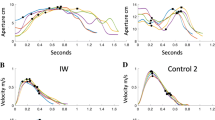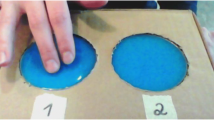Abstract
In this work, we investigate how local shape elements of a grasped object affect performance of haptic rotation. Blindfolded participants were asked to grasp a rotary knob using thumb and index finger and to rotate it 90\(^\circ \) counterclockwise around its own axis. The knobs exhibited a suitably distributed “grasp conform” combination of local shape elements (edged, flat or round). We tested all possible scenarios where both fingers had to grasp one of the three shape elements, resulting in a total of nine experimental conditions. Based on the rotation angle, determined with a novel apparatus named Twister, we evaluated the variable and signed errors. The results imply that a round rotary knob is the hardest to rotate by a correct goal angle, while other local shape elements can benefit the performance. Independent of the experimental condition, we found a bias towards rotating too far.
Access this chapter
Tax calculation will be finalised at checkout
Purchases are for personal use only
Similar content being viewed by others
Notes
- 1.
We refer to this rotation performed by touch only, as haptic rotation.
- 2.
References
Feix, T., Pawlik, R., Schmiedmayer, H.B., Romero, J., Kragic, D.: A comprehensive grasp taxonomy. In: Robotics, Science and Systems: Workshop on Understanding the Human Hand for Advancing Robotic Manipulation, vol. 2, pp. 2–3 (2009)
Fernández-Díaz, M., Travieso, D.: Performance in haptic geometrical matching tasks depends on movement and position of the arms. Acta Psychol. 136(3), 382–389 (2011)
Flanders, M., Soechting, J.F.: Frames of reference for hand orientation. J. Cogn. Neurosci. 7(2), 182–195 (1995)
Gentaz, E., Badan, M., Luyat, M., Touil, N.: The manual haptic perception of orientations and the oblique effect in patients with left visuo-spatial neglect. NeuroReport 13(3), 327–331 (2002)
Gentaz, E., Baud-Bovy, G., Luyat, M.: The haptic perception of spatial orientations. Exp. Brain Res. 187(3), 331 (2008)
Gentaz, E., Hatwell, Y.: Role of gravitational cues in the haptic perception of orientation. Atten. Percept. Psychophys. 58, 1278–1292 (1996)
Gentaz, E., Hatwell, Y.: The haptic oblique effect in the perception of rod orientation by blind adults. Percept. Psychophys. 60(1), 157–167 (1998)
Gentaz, E., Hatwell, Y.: Role of memorization conditions in the haptic processing of orientations and the ‘oblique effect’. Br. J. Psychol. 90(3), 373–388 (1999)
Howard, I.P.: Human Visual Orientation. Wiley, Hoboken (1982)
Kappers, A.M.L.: Large systematic deviations in the haptic perception of parallelity. Perception 28(8), 1001–1012 (1999)
Kappers, A.M.L.: Haptic perception of parallelity in the midsagittal plane. Acta Psychol. 109(1), 25–40 (2002)
Kappers, A.M.L.: The contributions of egocentric and allocentric reference frames in haptic spatial tasks. Acta Psychol. 117(3), 333–340 (2004)
Kappers, A.M.L., Viergever, R.F.: Hand orientation is insufficiently compensated for in haptic spatial perception. Exp. Brain Res. 173(3), 407–414 (2006)
Luyat, M., Moroni, C., Gentaz, E.: The role of contextual cues in the haptic perception of orientations and the oblique effect. Psychon. Bull. Rev. 12(4), 760–766 (2005)
Reisinger, J., Wild, J.: Haptische bedienschnittstellen. In: Reisinger, J., Wild, J. (eds.) Infotainmentsysteme im Kraftfahrzeug, pp. 115–145. Springer, Heidelberg (2008). https://doi.org/10.1007/978-3-8348-9430-4_4
Strub, C., Wörgötter, F., Ritter, H., Sandamirskaya, Y.: Correcting pose estimates during tactile exploration of object shape: a neuro-robotic study. In: 2014 Joint IEEE International Conferences on Development and Learning and Epigenetic Robotics (ICDL-Epirob), pp. 26–33. IEEE (2014)
Strub, C., Wörgötter, F., Ritter, H., Sandamirskaya, Y.: Using haptics to extract object shape from rotational manipulations. In: 2014 IEEE/RSJ International Conference on Intelligent Robots and Systems (IROS 2014), pp. 2179–2186. IEEE (2014)
Van Mier, H.I.: Haptic perception of parallelity. Psychol. Behav. Sci. 3, 212–221 (2014)
Volcic, R., Kappers, A.M.L., Koenderink, J.J.: Haptic parallelity perception on the frontoparallel plane: the involvement of reference frames. Atten. Percept. Psychophys. 69(2), 276–286 (2007)
Acknowledgment
This work was supported by the DFG Center of Excellence EXC 277: Cognitive Interaction Technology (CITEC) and the German-Japan Collaborative Research Program on Computational Neuroscience (RI 621/9-1). We would like to thank Risto Kõiva and his team for developing the Twister, Jan Anlauff for editing, and Christian Klarhorst for technical support and fruitful discussions.
Author information
Authors and Affiliations
Corresponding author
Editor information
Editors and Affiliations
Rights and permissions
Copyright information
© 2018 Springer International Publishing AG, part of Springer Nature
About this paper
Cite this paper
Krieger, K., Moringen, A., Kappers, A.M.L., Ritter, H. (2018). Influence of Shape Elements on Performance During Haptic Rotation. In: Prattichizzo, D., Shinoda, H., Tan, H., Ruffaldi, E., Frisoli, A. (eds) Haptics: Science, Technology, and Applications. EuroHaptics 2018. Lecture Notes in Computer Science(), vol 10893. Springer, Cham. https://doi.org/10.1007/978-3-319-93445-7_12
Download citation
DOI: https://doi.org/10.1007/978-3-319-93445-7_12
Published:
Publisher Name: Springer, Cham
Print ISBN: 978-3-319-93444-0
Online ISBN: 978-3-319-93445-7
eBook Packages: Computer ScienceComputer Science (R0)




